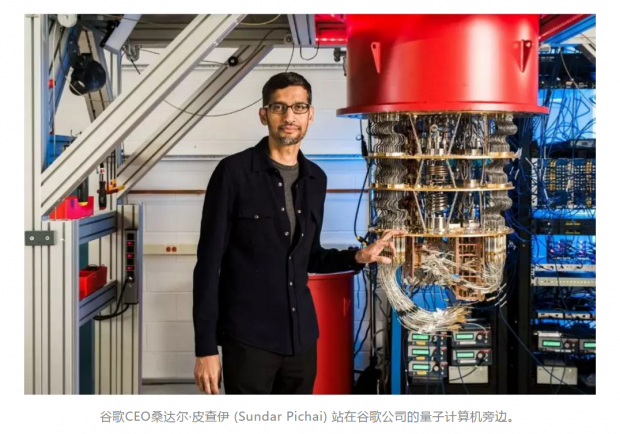阅读:0
听报道
撰文 | Frank Wilczek (麻省理工学院教授、2004年诺贝尔奖得主)
翻译 | 胡风 梁丁当

目前,绝大多数计算机都是处理由0、1组成的巨大数组。这两个二进制数字经常被称为比特。随着时代进步,物理学家和工程师们能够使用越来越小的器件来构建功能性比特。真空管和电磁继电器逐渐被现代化的集成电路所代替。一个可以轻易置入手机或者手表的小型芯片上聚集着数十亿个晶体管。而且晶体管的尺寸仍然在继续变小。
Currently, the vast majority of computers are machines that process huge arrays of 0s and 1s, also known as binary digits or simply bits. Over time, physicists and engineers have been able to create functional bits using smaller and smaller objects. Vacuum tubes and electromagnetic relays gave way to modern integrated circuits, which pack billions of transistors into chips that fit comfortably inside mobile phones or watches. And the transistors keep getting smaller.
然而,当微型化接近原子大小的时候——其实现在的晶体管不比原子大很多——我们便置身于一个崭新的世界:量子力学奇境。比特的量子版,即量子比特,可以是0和1的任意组合(用专业术语讲,即“叠加”)。相较于由比特构成的经典计算机,由量子比特构成的量子计算机的功能可能更加强大,但也更加复杂和脆弱。
But when miniaturization reaches the size of atoms-which are not much smaller than today's transistors-we find ourselves entering a new world: the wonderland of quantum mechanics. The quantum version of a bit, known as a qubit, can exist in a continuum of states that are mixtures (technically, "superpositions") of 0 and 1. Quantum computers built from qubits are potentially more powerful than classical computers built from bits, but they are also more complicated and delicate.
量子计算机已成为当今科学技术的前沿。量子比特的制造融合了低温科学、超导和新型光电电路,是一项开创性的杰出技术成就。但它们其实比基于现代晶体管的经典比特更大,而非更小。我们目前能够制造的量子计算机还没有实际用途。事实上,针对它们的研究主要还是着眼于未来。
Today, quantum computers are a research frontier. Qubits are brilliant and pioneering feats of engineering, which make use of cryogenics, superconductivity and new kinds of optoelectronic circuitry. But they are actually larger, not smaller, than modern transistor-based bits. The quantum computers that we can presently construct are not ready for practical use. Rather, they point to the future.
在这条发展道路上,“量子霸权”标志着一个里程碑:量子计算机能够完成一项复杂的计算,而这样的计算,通常的经典计算机无法在较短的时间内完成。谷歌的研究人员们最近在《自然》杂志上发表了一篇让人印象深刻的论文,宣称用一台名为Sycamore的处理器实现了量子霸权。让人惊讶的是,他们的这台量子计算机只由几十个低质量(或“噪声”较大)的量子比特构成,可它的性能却能够比肩由数百上千亿高质量比特所构成的最先进的经典计算机。
Along that path, "quantum supremacy" is meant to mark a milestone. It is the successful performance, using a quantum computer, of a computation that could not be carried out by a classical computer of reasonable size in a reasonable time. An extremely impressive paper by Google researchers recently appeared in the journal Nature, announcing that they had achieved quantum supremacy with a processor called Sycamore. It is startling to see that their quantum computer, based on a few dozen low-quality (or "noisy") qubits, can compete successfully with top-of-the-line classical computers, which work with billions or trillions of high-quality bits.
尽管如此,我们最好谨慎、全面地看待它。首先,Sycamore实现的只是非常特殊的计算。即使对一名物理学家来说,该计算听起来都很复杂,并没有明显的实用价值。而且,IBM的研究人员很快注意到,利用更好的算法的经典计算机也能在不太长的时间内完成。
Still, some perspective is in order. For one thing, the computation that Sycamore performed is very specialized. It is complicated to describe, even to physicists, and has no obvious practical use. Furthermore, IBM researchers quickly noted that better classical algorithms could perform almost as well.
而更加让人深思的则是量子霸权的意义。其实解决重要的定量问题时,我们不用量子比特也可以比任何经典计算机都快。随便一个碳原子,仅通过自己的行为,便能“计算”出一个非常重要的实际问题的答案--即碳会如何运动和变化?比如,通过检测气体碳在受热或激光辐射后的发射光谱,我们就可以“计算”出碳原子是如何辐射光子以及与光进行相互作用的。相比于任何超级计算机求解相关方程的速度,碳原子给出答案的速度显然快得多。而且这个方案很容易扩展:只要多用几个碳原子,你就可以解决化学中的一些重要 问题。
The most profound issue, however, concerns the meaning of quantum supremacy. After all, it doesn’t take qubits to solve important quantitative problems faster than any classical computer. Any carbon atom can "calculate" the solution of a very important practical problem—how does carbon behave? -simply by doing its thing. We can, for instance, "calculate" how carbon emits and interacts with light by examining the spectrum that gaseous carbon emits when heated or after exposure to laser light. Carbon atoms produce the answers much faster than any supercomputer can solve the relevant equations. And this strategy scales quite well: Using several carbon atoms, you can address important problems in chemistry.
毫无疑问,从长远来看,利用物质量子特性的计算机将大大地增强我们解决有用问题的能力。但我们距离这个目标还很遥远,甚至都不能确保一定成功。在可预见的将来,我们顶多只能在精心选择的应用中拥有“量子优势”,而并非在广泛的领域拥有“量子霸权”。
There's little doubt that, in the long run, computers that exploit quantum features of matter will dramatically enhance our ability to address useful problems. But we're not there yet, nor is success guaranteed. For the foreseeable future we will have, at best, a "quantum advantage" in wellchosen applications, not "quantum supremacy" along a broad front.
作者简介
Frank Wilczek:弗兰克·维尔切克是麻省理工学院物理学教授、量子色动力学的奠基人之一。因在夸克粒子理论(强作用)方面所取得的成就,他在2004年获得了诺贝尔物理学奖。
本文经授权转载自微信公众号「蔻享学术」。
话题:
0
推荐
财新博客版权声明:财新博客所发布文章及图片之版权属博主本人及/或相关权利人所有,未经博主及/或相关权利人单独授权,任何网站、平面媒体不得予以转载。财新网对相关媒体的网站信息内容转载授权并不包括财新博客的文章及图片。博客文章均为作者个人观点,不代表财新网的立场和观点。




 京公网安备 11010502034662号
京公网安备 11010502034662号 